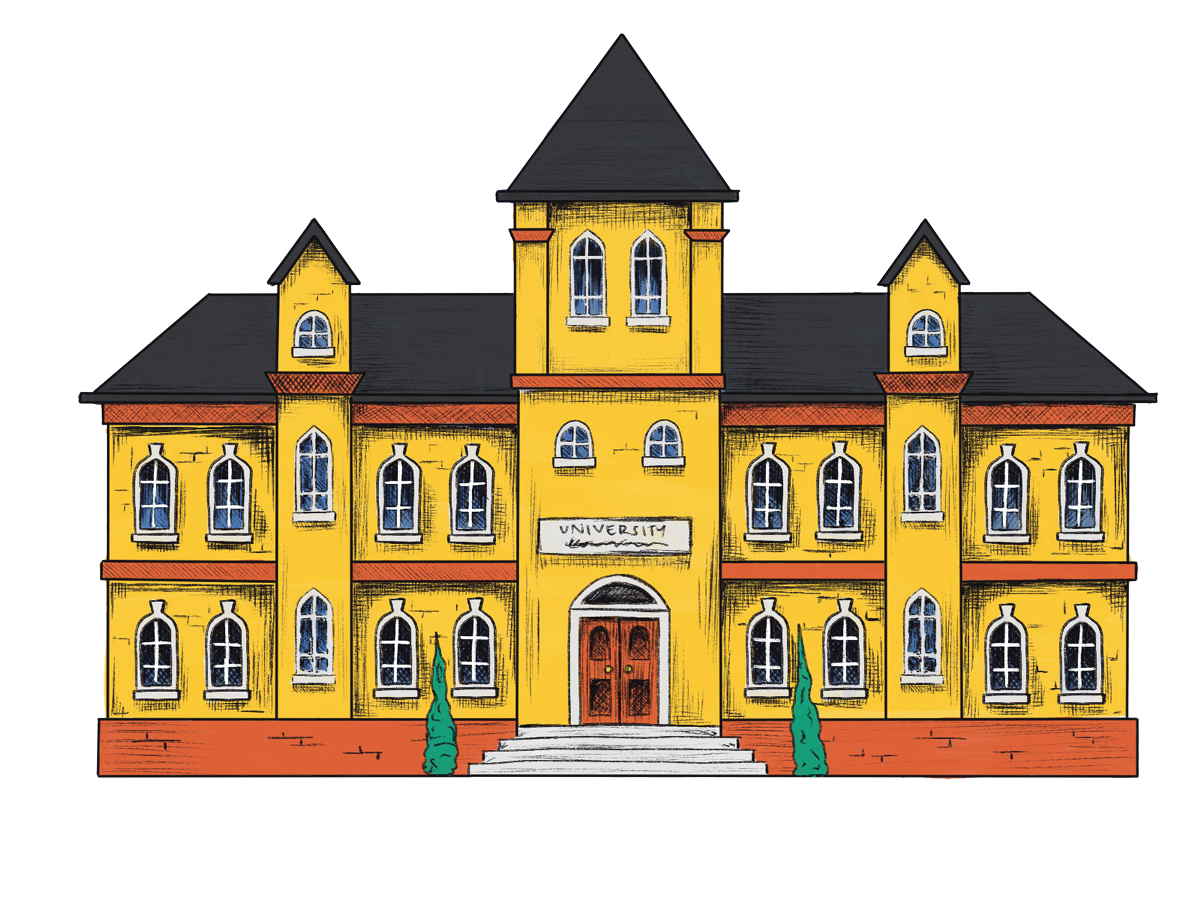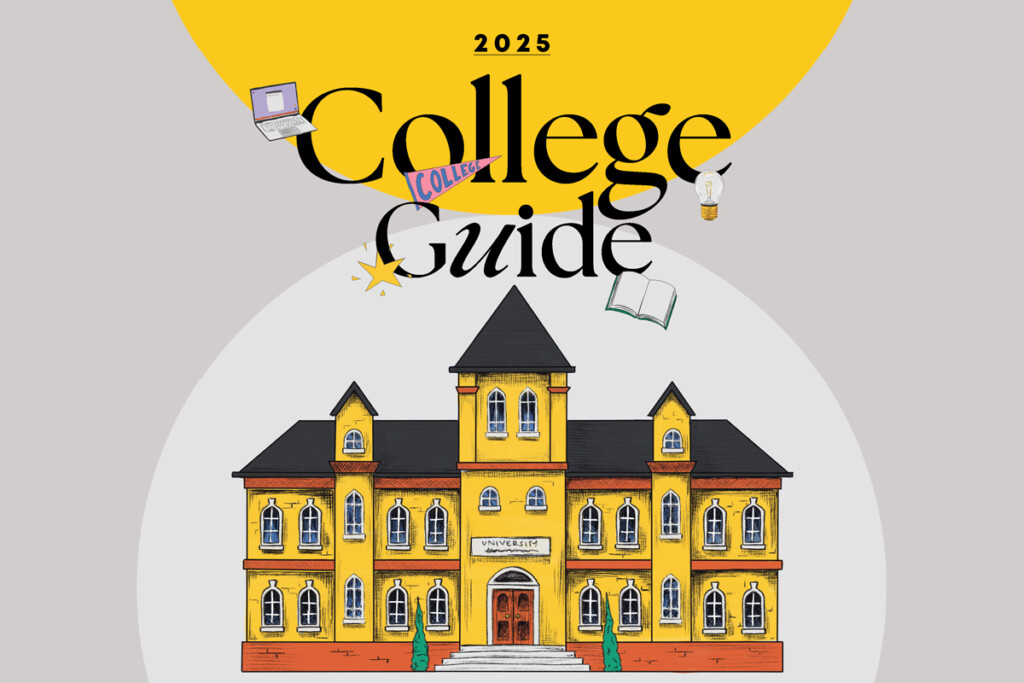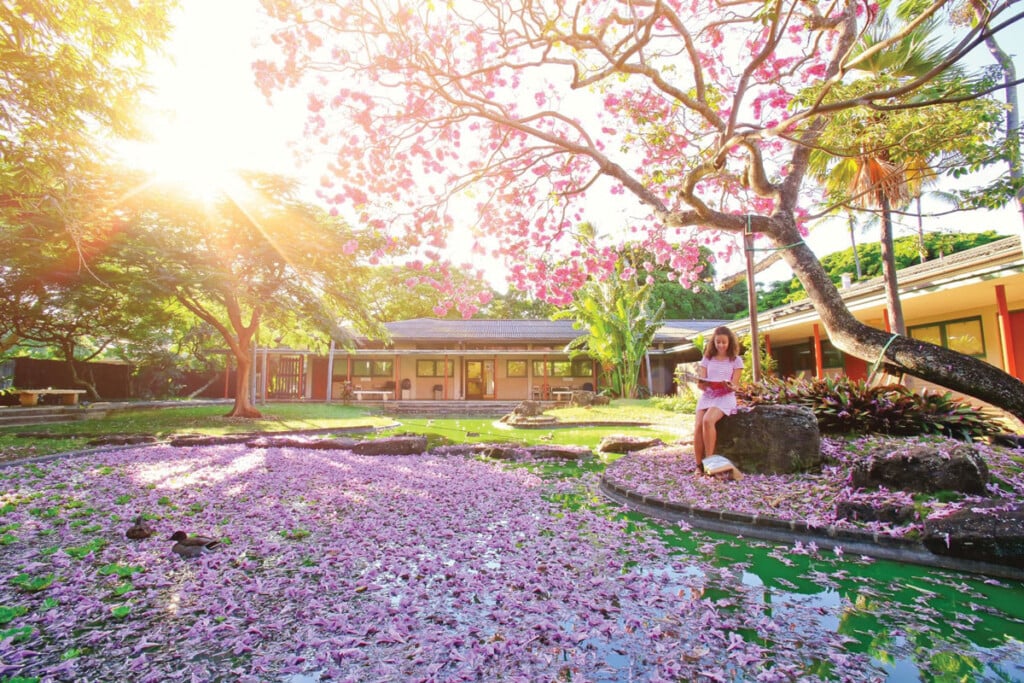2025 Hawai‘i College Guide: Is College Still Worth It?
Costs are sky-high, but administrators at schools popular among many Hawai‘i high school graduates say higher education gives students a valuable edge.

Is college still worth it? Increasing tuitions and rising student debt continue to fuel national debate about the value of postsecondary degrees.
Average U.S. college costs, including full-time tuition, fees, and room and board, have increased by 14% over the past 20 years, according to the U.S. Department of Education’s National Center for Education Statistics. Only 47% of American adults say those higher costs are worth it, provided students or their families don’t have to take out loans to pay for it. That rate decreases to 22% if a loan is needed, according to the Pew Research Center.
We spoke with administrators and admissions counselors at colleges that are popular among many Hawai‘i high school graduates, as well as with a college and career counselor at Campbell High School, the largest public high school in the state. Their unanimous verdict: College is still a worthwhile investment.
Research has long touted the college wage premium, in which the average four-year college graduate earns 65% more than the average nongraduate. Rigorous instruction gives college students the technical expertise and discipline they’ll need for their careers. But the administrators and counselors we spoke with say the soft skills that students develop are also noteworthy. College, they say, provides a unique environment where students can connect with others from around the world, engage with diverse perspectives, practice democracy and challenge themselves.
“Going to college is not just about receiving the academic knowledge; it’s about growing in all the ways a human can, and being a better version of themselves tomorrow than they were today or yesterday,” says Armen Sarkisian, director of first year admission at Chapman University.
Sticker Price Vs. Actual Cost
It can be a shock to learn that the average annual cost of attending a public college full-time is $20,000 (and that’s for students who are residents of the state); for private colleges, it’s $49,000. But there’s a difference between a college’s sticker price and what students will actually pay. Nationally, more than 85% of full-time undergraduate students receive some type of financial aid, lowering actual costs.
It’s important for students and their families to look beyond that sticker price and consider whether merit scholarships, need-based gifts or financial aid could help, Sarkisian says.
In the early 2000s, Chapman University’s presidential scholarships reduced the cost of yearly tuition there by $20,000. These scholarships are now worth $40,000 to account for higher tuition.
For context, the total cost of attendance at Chapman, including tuition, fees, room and board, travel expenses to and from home, and spending money, is about $87,000 per year, Sarkisian says. Back when he attended the California campus in the early 2000s, the total cost was about $30,000.
“There’s obviously all these big concerns and tuition continues to go up, and is it the next bubble, is education the next bubble, and for how long can these tuition increases continue to be sustained?” Sarkisian says. “But there are major efforts across the board at most institutions in the U.S., especially in the private sector, where we are trying to offset those increases to provide access to students by fundraising and having operations driven from endowment resources.”
UH’s board of regents froze undergraduate tuition at UH Mānoa for academic years 2023-24 and 2024-25. UH also waived its application fees for Hawai‘i residents applying to any of its campuses. For the current school year, the annual full-time tuition at UH for residents is $11,304; with additional expenses such as books, room and board, and transportation, the estimated total cost is $32,316.
“We’ve been taking a really close look at things that can often be barriers to higher education, the application fee being one of them,” says Nikki Chun, vice provost for enrollment management at UH Mānoa. “And I think that’s what also opened the doors for a lot of our Hawai‘i residents to be like, ‘Oh, well, I mean, you know, if it’s free,’ and that’s what we needed. Honestly, we just needed them to apply. And once they applied, we just found that there were so many more qualified students to admit.”
The campus also offers accepted in-state students merit scholarships of up to $4,000 a year if they have GPAs of 3.0 or higher.
Worthwhile Investment
Sarkisian says he tells students that, “I wouldn’t do the work I do and talk about Chapman the way I do if I generally didn’t think we were worth what our sticker price is. I feel wholeheartedly that we deliver to that value of providing an experience, not just in education and academic knowledge, but a full experience that lives up to that total cost of attendance.”
Part of what makes college degrees valuable is that they retain their worth over time. Eleyne Fia, a college and career counselor at Campbell High School, says degrees demonstrate to employers that young adults have the required technical knowledge and can interact with others, communicate well and finish what they start. Certifications, by comparison, generally need to be renewed every so often, such as when new technology or methods become available.
To help justify the cost of tuition and fees, she encourages her students and their families to remember that college is about more than just the classes. Students have access to tutors, career centers, job fairs and internships where they can learn about their interests, talk with hiring managers before applying for open jobs and get real-world experience. Campuses commonly provide low-cost health services, host visiting scholars and musicians, and more.
Among the “more,” Fia points to study-abroad programs, “where you’re able to stay in another country and live and learn.”
“Where else,” she asks, can young adults have that opportunity, at that price? “It’s all included in what you pay for, all those services on that campus.”
Changing Student Expectations
Given the state of the economy, school officials say students want to know how a college degree will help them enter the workforce and be competitive once they’re there. And they’re asking questions about how they can develop practical skills and whether campuses offer hands-on opportunities for them to apply their knowledge in supportive, real-world settings.
“There’s a lot more pressure and a lot more anxiety around not only getting into college, but getting into the major and getting into a field that will benefit them economically,” says Ed Taylor, vice provost and dean of undergraduate academic affairs at the University of Washington.
Educational leaders for years have encouraged youths to pursue science, technology, engineering and math careers. That’s led to an unintended consequence of placing higher value on those types of programs. Taylor says he’s seen many students pursue STEM majors for that reason, rather than following their hearts. He adds that UW now goes further to articulate to students the value of its various degrees and how they can translate into career opportunities.
Also, several of the administrators we spoke with say their colleges have increased opportunities for hands-on learning, such as through student research. About 6,700 undergraduate students at UW, for example, participated in nearly 1.3 million hours of research with faculty mentors during the 2022-23 academic year.
“We have found that students that engage in research with their faculty, they are … least likely to get lost in university, that they actually deepen their commitment, they deepen their knowledge,” Taylor says.
Michael Bruno, provost of UH Mānoa, says the campus now engages hundreds of students annually in its Undergraduate Research Opportunities Program, which provides funding and faculty mentors. Projects have included investigations into the issues faced by Micronesian migrants living in O‘ahu public housing projects and more.
Prospective college students also look for whether campus equipment, labs, facilities, academic programs and resources are up to date. Chapman University has invested more than $1 billion in its facilities over the past 20 years, Sarkisian says. The college has also added several high-ranking faculty members to its staff and invested in student services.
“You can see it’s palpable. You walk our campus community and you can feel that the university has been very thoughtful about the investment in these spaces to deliver the opportunity for students to have our mission meet their experience,” he says.
UH Mānoa has several renovation projects underway, including a $57 million state-of-the-art Student Success Center. The center will house 30 conference rooms, a computer lab, a student store for food and beverages, the campus’ esports team, and digital studios for the College of Social Sciences. UH Mānoa is also creating more outdoor studying and gathering spaces as a result of student feedback.
The campus has also changed up some of its academic offerings, including adding new programs to its School of Cinematic Arts and a new undergraduate degree in sustainability, Bruno says.
How to Maximize Your College Experience
Join a student club. Help a faculty member with research. Get involved with student government. Join an intramural sports team. Getting involved is one of the best ways students can maximize their college experiences, according to college administrators.
And it paves the way for students to make friends and meet people from all over the world. The University of Nevada-Las Vegas has more than 420 student clubs and organizations, with students from all 50 states and more than 85 countries, says Woody Hoshibata, a senior regional recruiter there. He says students shouldn’t be afraid to be vocal about what they want. If they want to work with a specific faculty member, they can show up at that faculty member’s office and say, “I’m interested in what you do. How can I learn about that, or how can I get involved?” They can also speak with their campus’ academic advisers for guidance, he says.
And it’s best to get involved as early as possible. Sarkisian recalls running into a Chapman freshman from Hawai‘i a few years ago. While it was only the second or third month of school, she was already engaged in research with a faculty member. He says getting involved early is akin to earning power.
“By the time they graduate, you look at their résumé and you hear them talk about what they did during their college time, and you’re like, ‘How did you do that in four years?’” he says. “And really what it amounts to is they’re entering the real world with a very impressive skill set and experience set that is usually going to outpace most of their peers.”

The Right Fit
Grace Lenore Rogers | Senior, Emerson College
Grace Lenore Rogers, a Kalāheo High School graduate, was set on double-majoring in musical theater and education with the goal of becoming a performing arts educator at a public school. She was drawn to Emerson College because it had a specific major that combined her two career interests: theater education and performance. Although she initially was interested in other schools, Emerson proved the perfect fit for her because of its robust student-run arts community, where students initiate and pursue projects such as original plays and musicals, script readings and student-directed films.
“Everyone [at Emerson] is so passionate about what they are doing,” she says. “There’s something really special about the art that we make together.”
The 20-year-old senior says Emerson gave her the opportunity to grow as a person, in ways she couldn’t while living at home. Growing up as a military kid, she had moved around a lot and found it difficult to connect with her high school classmates. But her heart is now in Boston, and she says the friends and memories she’s made there are invaluable.
She advises high schoolers just starting the college application process to focus on schools that fit them and their passions rather than getting caught up in prestigious names and acceptance rates. “The lists of ‘top best schools’ don’t mean anything,” she says. “You can go to the best school in your industry, but if it doesn’t work for you, it’s not right. I think it’s really important to tour schools (if you can) and talk to current students and alumni to really feel the vibe. It’s so much more important to find a school that fits your wants and needs and your goals in life.”
—Hailey Akau

Taking the Leap
Issiah Angel Scarborough | Senior, University of Oregon
Issiah Angel Scarborough was born in Texas but raised in Hawai‘i, growing up at Schofield Barracks while his father was deployed overseas. Although he always thought he would follow his father’s military path, he realized while attending Saint Louis School that he could forge his own way.
The 22-year-old senior is now poised to be the first person in his family to graduate from college, something he is proud of and believes will lead to expanded career opportunities.
He says being independent as a child gave him the confidence to even apply. The University of Oregon landed on Scarborough’s radar after he received personalized recruiting mail from the school with the correct spelling of his first name. He says it made him feel like he was more than just a number or someone who could meet a quota. “They made me feel like I belonged there,” he says. “I felt almost like I had an attachment to [the University of Oregon] even though I’d never been there before.”
He graduated from high school in 2020 at the peak of the COVID-19 pandemic, making his senior year far from normal. But the university, Scarborough says, did everything it could to make his decision easier, through letters, Zoom calls and even sending cardboard VR glasses so he could virtually tour the campus.
Scarborough, now in his fifth year at the university, started out as an architecture major but switched to a double-major in finance and marketing and cinema studies. Film was always a big interest, but he wanted to explore both of his passions to determine which might ultimately lead to a career.
“My biggest advice to high school students would be to find that balance of being comfortable and uncomfortable,” he says.
If he hadn’t taken the risk of leaving his family and going to Oregon, he says he would have missed out on valuable work and learning opportunities that he believes have set him up for a solid career and future.
—Hailey Akau

Networking Locally
Kelsey Yoshioka | Junior, University of Hawai‘i at Mānoa
Born and raised on O‘ahu, Kelsey Yoshioka says she always intended to stay on-island after graduating from ‘Iolani School, and she credits her parents for motivating her to go to college. “I know [my parents] made a lot of sacrifices to send me to ‘Iolani,” she says. “I really wanted to make sure I could get a good degree to set me up for a job with a solid income.”
Knowing the high expense of higher education, the 20-year-old nursing student considered her family’s finances when deciding on which college to attend. Although she considered some West Coast schools, she ultimately enrolled at UH Mānoa. She says she had always been interested in health care and knew that UH’s program could offer her a fulfilling learning experience and local networking opportunities.
Her rigorous course load was overwhelming at first, but she says it forced her to mature and kept her on track. “It’s definitely been helpful for networking, and there are so many young nurses who have taught me a lot and helped me sort of toughen my skin in the industry,” she says.
This past summer, she was selected for an internship with Hawai‘i Pacific Health, giving her firsthand health care experience. She was able to rotate among different departments to see different parts of the industry. “I really feel like I’m on the right track to a steady income and good future,” she says, “which is definitely why I think college is worth it. Even if you have to take things at your own pace or take a break from school, I still think that an educational foundation for your career is important.”
—Hailey Akau
 Crunching the Numbers at UH Mānoa
Crunching the Numbers at UH Mānoa Upcoming Dates
Upcoming Dates








